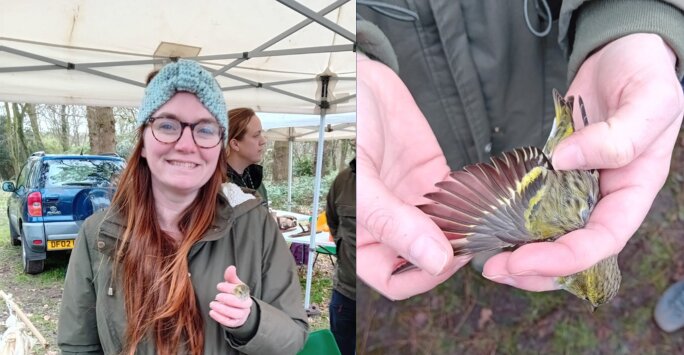
Dr Becky Verspoor is a Lecturer in the School of Biosciences, as well as a member of Merseyside Ringing Group. Here, Becky tells us about her exploits ringing a selection of birds at Ness Gardens for members of the public.
Hey there bird enthusiasts! Have you ever wondered how scientists keep tabs on our feathered friends? Well, let me introduce you to the fascinating world of bird ringing, also known as bird banding.
Picture this: tiny, lightweight rings, are carefully attached to the legs of birds. It’s just like you wearing your watch so doesn’t upset the birds too much! These rings are like little ID tags, helping researchers track the movements, behaviours, and populations of our avian friends without causing any harm.
So, how does it work? Bird ringers, armed with mist nets or traps, carefully catch birds and gather important data like species, age, sex, and health before ringing them and setting them free. Then, when another ringer catches the same bird or if a member of the public finds a ringed bird, we can learn more about its individual journey.
Now, why is this important? Well, bird ringing provides crucial data for scientific research, helping us understand migration patterns, population changes, and the impacts of environmental shifts. By recapturing ringed birds, scientists can study things like survival rates, breeding success, and behaviour over time. Plus, finding those rings can reveal a bird's lifespan and migration routes, which is key for global conservation efforts.
Here's where things get exciting for us locals! The Merseyside Ringing Group (MRG) is our go-to team for bird ringing in the Merseyside area. We often host ringing demonstrations for the public, like the one I ran at Ness Gardens recently alongside other MRG members.
Mist nets were set up early in the morning and checked every 20 minutes for new birds. And boy, did we have a turnout! Over 100 adults and nearly 50 children swung by our ringing tent, some coming from as far as Macclesfield and even Liverpool (props to the cyclist who cycled all the way!). We also had almost 50 birds too!
We snagged some cool species, like the feisty Great Spotted Woodpecker. Handling her took some skill, as these woodpeckers can be a bit aggressive up close - a job for myself, rather than a member of the public! You can see here that this was a female as there is no extensive red colouring along the back of the head, which you would see if this was a male.

I was then very happy to catch a siskin as I’d never ringed one before and the public really enjoyed seeing this bird in the hand, though not as much as when I pulled a robin out of the bird bag! Now that was quite the ‘ooooh’ that went round the crowd!
Now, let's dive into the fascinating world of ageing a bird! One of the key clues we bird ringers look for is something called old greater coverts (OGCs). You see, young birds go through a fancy process called a 'post-juvenile moult', where they shed parts or all of their first (juvenile) plumage—the feathers they grew while snug in the nest. This makeover usually happens once they've taken their first flights out into the world.
Now, here's where it gets interesting: the extent of this moult can give us a clue about the bird's age. Take, for example, the siskin below. See those fancy feathers? Those are the greater coverts. Amongst them, you'll spot some adult feathers, all shiny and sporting lovely yellow tips. But look closer, and you'll spy three feathers that aren't as flashy—those are the juvenile ones, lacking the vibrant yellow tips. And that's the tell-tale sign: this little siskin is still a juvenile, just starting its journey into adulthood. Pretty neat, right?

What a day it was at the ringing demonstration! The public couldn't get enough, with people coming back again and again to see what feathered friends we had caught. Some of the little ones showed up armed with their mini bird books and binoculars, ready to soak up all the bird-watching action. It was heart warming to see the spark of inspiration in their eyes, leaving them eager to explore more of the avian world.
But you know what really stole the show? The sheer joy on people's faces when they got to set those birds free! There's something truly magical about witnessing those fleeting moments of freedom, as our winged buddies take flight back into the wild where they belong. It's moments like these that remind us of the beauty and wonder of nature, and the importance of cherishing and protecting it for generations to come.
So next time you see a little ring on a bird's leg, know that it's not just bling – it's part of a bigger mission to understand and protect our feathered friends!